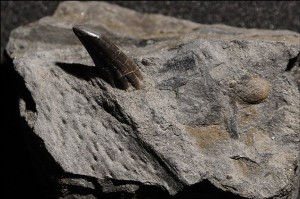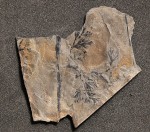 Something happened 360 million years ago during the end of the Devonian period. A mass extinction event devastated marine and terrestrial life thoroughly enough that very few fossils have been found dating to between 360 and 345 million years ago. The end of the Devonian and the first 15 million years of the Carboniferous period leave a gap in the fossil record known as Romer’s Gap, after paleontologist Dr. Alfred Romer who first identified it.
Something happened 360 million years ago during the end of the Devonian period. A mass extinction event devastated marine and terrestrial life thoroughly enough that very few fossils have been found dating to between 360 and 345 million years ago. The end of the Devonian and the first 15 million years of the Carboniferous period leave a gap in the fossil record known as Romer’s Gap, after paleontologist Dr. Alfred Romer who first identified it.
A number of theories have been proffered to explain the gap: a drop in oxygen levels caused by high volcanic activity that made it hard to sustain life on land, geological conditions inimical to fossil creation, or a simple failure to dig in the right place. That last theory has at least in part been borne out by the discovery of hundreds of newly unveiled early Carboniferous fossils in Scotland.
 Paleontologists have found an impressive variety of fossils from several newly explored sites east of Edinburgh, including the banks of the Whiteadder and Tweed rivers. Fossils include amphibians — including one vertebrate named “Ribbo” for his well-defined ribs — plants, fish and invertebrates.
Paleontologists have found an impressive variety of fossils from several newly explored sites east of Edinburgh, including the banks of the Whiteadder and Tweed rivers. Fossils include amphibians — including one vertebrate named “Ribbo” for his well-defined ribs — plants, fish and invertebrates.
The Scottish discoveries are four-legged life forms, some of the first to walk the land, and demonstrate that having five fingers and toes arose about 20 million years earlier than paleontologists had theorized.
“Everything is getting pulled back in the fossil record,” said Jennifer Clack, a paleontologist at the University of Cambridge in the U.K. and study author. “This gives us a clue to how quickly that the ability to walk on land with a conventional foot evolved — much faster than previously thought.” […]
The new information suggests that life recovered from a known mass extinction event at the end of the Devonian period, which was about 359 million to 416 million years ago, more quickly than researchers had once thought. Fish groups evolved into big freshwater forms including lungfishes, which can breathe air, and rhizodonts, which are now extinct. By 345.3 million years ago, animals that are usually considered to be land-dwellers had appeared.
 Researchers also found charcoal deposits along with the fossils. They’re hoping to be able to identify the plants that were partially burned long enough to turn to charcoal, and thus to get a better idea of the environment they lived in.
Researchers also found charcoal deposits along with the fossils. They’re hoping to be able to identify the plants that were partially burned long enough to turn to charcoal, and thus to get a better idea of the environment they lived in.
Sir David Attenborough is psyched that new sites of great paleontological significance have been found in Scotland at all, given how thoroughly it’s been picked over. He said: “One is accustomed these days to hear of sensational new fossil finds being made in (other) parts of the world. But to learn of a site in this country, which must surely be counted among the most extensively explored, in geological terms, is wonderful and exciting.”
A collection of Romer’s Gap fossils will be on display at the National Museum of Scotland from Tuesday, March 6th until April 29th.